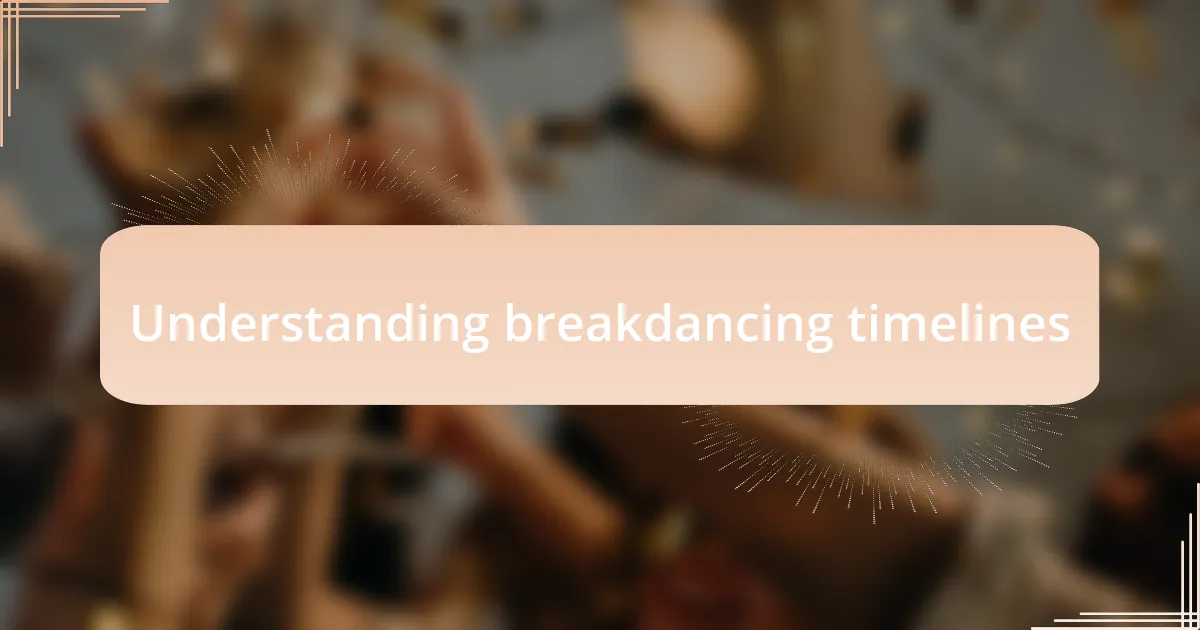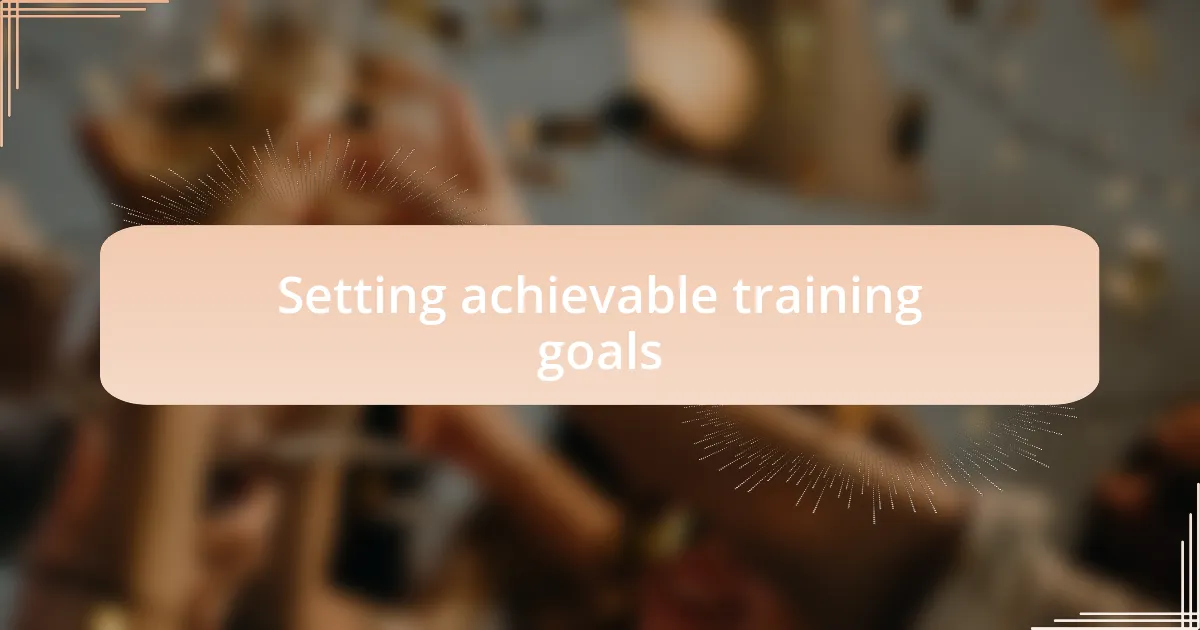Key takeaways:
- Understanding and setting realistic timelines is crucial for mastering breakdancing moves and enhancing motivation.
- Breaking down goals into smaller, achievable milestones fosters a sense of progress and maintains enthusiasm.
- Balancing practice with personal life helps prevent burnout and makes the journey more enjoyable.
- Sharing goals and collaborating with others strengthens community connections and boosts accountability in training.

Understanding breakdancing timelines
Understanding the timelines in breakdancing can truly transform your practice. Each move, from the foundational steps to complex freezes, requires dedicated time to master. I remember when I struggled with the windmill; it took weeks of persistent practice before I could execute it smoothly. Have you ever felt that frustration?
With breakdancing, setting realistic timelines is essential for progress. It’s not just about practicing for hours; it’s about knowing which skills to focus on at the right time. I often advise new dancers to break down their goals into smaller, manageable milestones. For instance, mastering a six-step might take a few days, while perfecting your power moves could require months of commitment and patience.
I find that each dancer’s timeline can vary dramatically based on their previous experience, dedication, and even their physical condition. Have you ever compared your journey with someone else’s? It’s crucial to remember that everyone’s path is unique, and respecting that can help maintain motivation amidst challenges. Embracing a flexible approach to timelines ensures that you enjoy the process instead of feeling bogged down by unrealistic expectations.

Importance of realistic timelines
Setting realistic timelines is crucial in any skill development, especially in a dynamic art form like breakdancing. When I first started, I often set my sights too high and ended up disappointed. Have you ever pushed yourself to master a move only to feel disheartened when it didn’t happen fast enough? I learned that when I adjusted my expectations, not only did I progress more steadily, but I also enjoyed the journey far more.
It’s not just about the end goal; it’s about celebrating the small wins. I distinctly remember finally landing my first freeze after weeks of effort. The thrill was more rewarding than I ever imagined! By setting achievable timelines, I’ve found that I can sustain my enthusiasm, which keeps me dancing and improving. Isn’t it incredible how realistic expectations can turn frustration into motivation?
Moreover, realistic timelines foster a sense of community among dancers. Sharing our journeys helps us connect, and we often laugh about how long it took to nail certain moves. Have you ever found solace in hearing someone else’s struggles? Knowing that others face similar challenges reinforces our commitment to progress and promotes a positive atmosphere within breakdancing circles.

Setting achievable training goals
One of the most valuable lessons I learned in my breakdancing journey is the importance of incremental goals. Early on, I would aim to master complicated routines within a week, but I just ended up frustrated. Instead, I started breaking down these routines into smaller, manageable pieces, focusing on perfecting just one move at a time. This strategy not only gave me clear objectives but also allowed me to appreciate the little victories along the way. Hasn’t anyone else experienced that rewarding feeling of finally getting a single move down?
When I first tried to spin, I rushed the process, eager to show off my skills. However, I quickly realized that every element of breakdancing requires patience and practice. So, I began setting aside specific practice sessions dedicated to just footwork. This focused approach helped me gain confidence and ultimately develop my dancing without feeling overwhelmed. How great is it to see improvement from effort well spent?
Additionally, having a training buddy can really help in setting achievable goals. I remember teaming up with a fellow breaker to set weekly targets based on our skill level. This camaraderie not only kept us accountable but also turned every training session into a fun challenge. Can you think of someone you could practice with to share your goals and triumphs? Working together can make the process less daunting and deepen your connection to the dance community.

Balancing practice with personal life
Finding a balance between practice and personal life is essential for staying motivated in breakdancing. I’ve learned the hard way that neglecting friendships and family can lead to burnout. Once, I found myself skipping social events just to get extra practice in, but I realized these moments are just as important for my growth. Who doesn’t cherish those connections and shared experiences?
To strike that balance, I started setting a practice schedule that included downtime with friends and family. I carved out time intentionally to chill, watch movies, or hit the streets with friends. I discovered that when I returned to my practice after those breaks, I was more energized and creative. Doesn’t it feel refreshing to step away sometimes and come back with a fresh perspective?
Moreover, I found that integrating breakdancing into daily activities made it less of a chore. Whether I was teaching a friend a move or jamming to my favorite tunes at a gathering, I realized I could share my passion without sacrificing personal connections. Isn’t it amazing how involving others in your journey can make the practice feel lighter and more enjoyable?
![]()
Using milestones for progress tracking
Setting milestones is a game-changer when it comes to tracking progress in breakdancing. For instance, I made it a point to celebrate small achievements, like mastering a new move or feeling more confident in my transitions. Each time I hit a milestone, it recharged my motivation—almost like unlocking a new level in a video game. Have you ever felt that exhilarating rush of accomplishment?
I remember vividly the excitement of planning my first mini-performance for friends. I treated it as a milestone, and the preparation took my practice to another level. Knowing I had to showcase my skills pushed me to refine my routines, and the support I received from friends during that event was incredibly rewarding. Isn’t it amazing how external goals can deepen your commitment to your craft?
Moreover, I found that setting specific dates for these milestones helped me stay accountable. It turned practice into a structured yet dynamic process, allowing me to visualize my progress. By sharing these goals with my breakdancing buddies, we kept each other on track, and it transformed our sessions into collaborative mini-competitions. Isn’t it powerful to have a team cheering you on while you chase your dreams?

Tips from my breakdancing journey
When I look back on my breakdancing journey, one thing stands out: the importance of setting realistic timelines. Early on, I had a tendency to be overly ambitious, thinking I could nail complex moves in a week. The reality? It often took me a month or more. Each time I misjudged my timeline, it created unnecessary frustration. Has that ever happened to you? I finally learned to break each skill into smaller, manageable parts, allowing me to feel a sense of achievement along the way.
During my training, I made it a habit to allocate specific times throughout the week to work on particular moves. This not only provided structure, but it also built anticipation. I distinctly remember the thrill when I finally managed to link my transitions smoothly; it felt like a small victory that boosted my confidence. Can you remember a moment in your practice where patience paid off? Those moments are priceless.
Sharing my timelines with fellow dancers was another game-changer. They held me accountable, and in return, I encouraged them, creating a supportive atmosphere. I think about this one time when a friend and I set a timeline to learn a duet together. The excitement of working towards a shared goal made the practice sessions feel less like work and more like a fun adventure. Isn’t it incredible how collaboration can turn a solitary journey into something much more enjoyable?